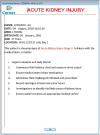Impact of electronic AKI alert/care bundle on AKI inpatient outcomes: a retrospective single-center cohort study
- PMID: 38345055
- PMCID: PMC10863540
- DOI: 10.1080/0886022X.2024.2313177
Impact of electronic AKI alert/care bundle on AKI inpatient outcomes: a retrospective single-center cohort study
Abstract
Background: Outcomes among acute kidney injury (AKI) patients are poor in United Kingdom (UK) hospitals, and electronic alerts and care bundles may improve them. We implemented such a system at West Suffolk Hospital (WSH) called the 'AKI order set'. We aimed to assess its impact on all-cause mortality, length of stay (LOS) and renal function among AKI patients, and its utilization.
Methods: Retrospective, single-center cohort study of patients ≥ 18 years old with AKI at WSH, a 430-bed general hospital serving a rural UK population of approximately 280,000. 7243 unique AKI events representing 5728 patients with full data were identified automatically from our electronic health record (EHR) between 02 September 2018 and 1 July 2021 (median age 78 years, 51% male). All-cause mortality, LOS and improvement in AKI stage, demographic and comorbidity data, medications and AKI order set use were automatically collected from the EHR.
Results: The AKI order set was used in 9.8% of AKI events and was associated with 28% lower odds of all-cause mortality (multivariable odds ratio [OR] 0.72, 95% confidence interval [CI] 0.57-0.91). Median LOS was longer when the AKI order set was utilized than when not (11.8 versus 8.8 days, p < .001), but was independently associated with improvement in the AKI stage (28.9% versus 8.7%, p < .001; univariable OR 4.25, 95% CI 3.53-5.10, multivariable OR 4.27, 95% CI 3.54-5.14).
Conclusions: AKI order set use led to improvements in all-cause mortality and renal function, but longer LOS, among AKI patients at WSH.
Keywords: Acute kidney injury; care bundle; electronic alerting; quality improvement; renal failure.
Conflict of interest statement
The authors declare that they have no competing interests. The results presented in this paper have not been published previously in whole or part, except in abstract format.
Figures




Similar articles
-
Electronic alerts and a care bundle for acute kidney injury-an Australian cohort study.Nephrol Dial Transplant. 2023 Feb 28;38(3):610-617. doi: 10.1093/ndt/gfac155. Nephrol Dial Transplant. 2023. PMID: 35438795
-
A simple care bundle for use in acute kidney injury: a propensity score-matched cohort study.Nephrol Dial Transplant. 2016 Nov;31(11):1846-1854. doi: 10.1093/ndt/gfw087. Epub 2016 May 4. Nephrol Dial Transplant. 2016. PMID: 27190331
-
A simple real-time model for predicting acute kidney injury in hospitalized patients in the US: A descriptive modeling study.PLoS Med. 2019 Jul 15;16(7):e1002861. doi: 10.1371/journal.pmed.1002861. eCollection 2019 Jul. PLoS Med. 2019. PMID: 31306408 Free PMC article.
-
Impact of AKI care bundles on kidney and patient outcomes in hospitalized patients: a systematic review and meta-analysis.BMC Nephrol. 2021 Oct 8;22(1):335. doi: 10.1186/s12882-021-02534-4. BMC Nephrol. 2021. PMID: 34625046 Free PMC article.
-
Acute Kidney Injury in Primary Care: A Review of Patient Follow-Up, Mortality, and Hospital Admissions following the Introduction of an AKI Alert System.Nephron. 2020;144(10):498-505. doi: 10.1159/000509855. Epub 2020 Aug 20. Nephron. 2020. PMID: 32818930 Review.
Cited by
-
Development and Implementation of an Evidence-Based Electronic Request Bundle for Metabolic Screening in Patients With Urinary Tract Calculi.Cureus. 2024 Nov 11;16(11):e73448. doi: 10.7759/cureus.73448. eCollection 2024 Nov. Cureus. 2024. PMID: 39664142 Free PMC article.
-
Circadian Clock Gene Bmal1: A Molecular Bridge from AKI to CKD.Biomolecules. 2025 Jan 7;15(1):77. doi: 10.3390/biom15010077. Biomolecules. 2025. PMID: 39858471 Free PMC article. Review.
-
Artificial intelligence and predictive models for early detection of acute kidney injury: transforming clinical practice.BMC Nephrol. 2024 Oct 16;25(1):353. doi: 10.1186/s12882-024-03793-7. BMC Nephrol. 2024. PMID: 39415082 Free PMC article. Review.
References
-
- NICE . Acute kidney injury: quality standard [QS76]. 2014.
MeSH terms
LinkOut - more resources
Full Text Sources
Other Literature Sources
